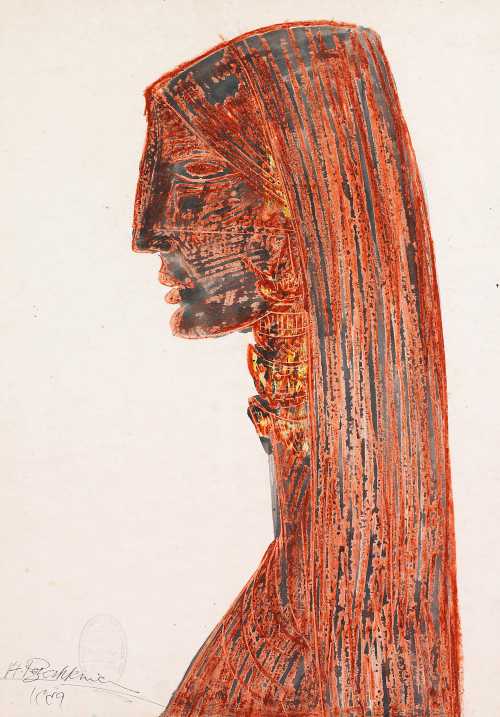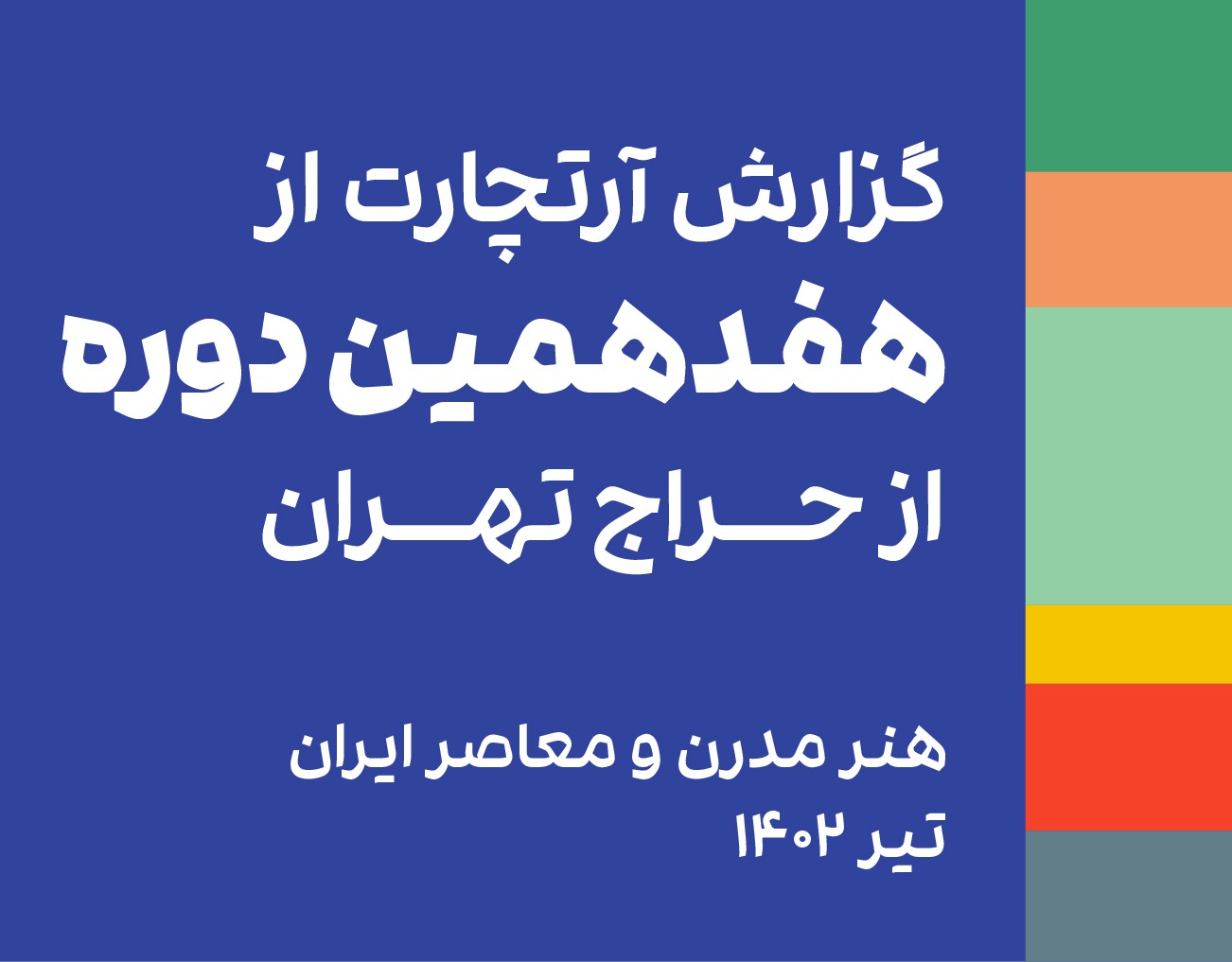About Houshang Pezeshknia
Houshang Pezeshknia is an Iranian painter and filmmaker, and one of the pioneers of Iranian modern art. Many consider him a pioneer in the importation of modernist art in Iran. Pezeshknia was the first painter of the first generation of modernists to become acquainted with modernist currents more directly by studying art abroad. As a teenager studied at the "Nezam school" in 1932 and became interested in painting through friendship with two students of Kamal-ol-Molk. After graduating in history and geography, in 1942 at the age of 25 he left for Turkey. After studying painting and art history and getting acquainted with different styles of modernism with a French professor named Leopold Levy, at the Istanbul Academy of Fine Arts he returned to Tehran and joined the circle of Pioneers of Iranian Modern Art.
After the experience of holding his first exhibition with Hossein Taherzadeh Behzad at the Iranian ambassador in Istanbul in 1944, he held the first solo exhibition at the Iranian-British Cultural Relations Association in Tehran. Collaboration with "Apadana, the home of fine arts" –the first private gallery in Iran – provided Pezeshknia a good opportunity for the success and reputation in the cultural and artistic community of that time. Apadana Gallery devoted its second official exhibition in December 1949 to Pezeshknia's artworks. It was at this exhibition that intellectuals such as Jalal al-Ahmad praised his paintings. Pezeshknia’s works along with the works of Kazemi, Esfandiari, Ziapour, etc. were displayed at the third program of Apadana Gallery in December of the same year.
In his professional life, Pezeshknia had various experiences that make it difficult to classify his works in a single style. Some of the modern styles such as Expressionism, Cubism, Impressionism and the so-called "open composition" that were popular among Iranian modernists in those decades can be found in his works. Although he himself did not consolidate these scattered experiences and did not bring clear results, some of his experiences opened up new horizons for other Iranian painters. Generally the painters of this generation tried to use the potentials of Iranian art to achieve a new and indigenous expression. Similarly, Pezeshknia made significant efforts in this direction. Parviz Kalantari mentions Pezeshknia as the initiator of calligraphy in Iranian art. According to him, Pezeshknia was the first painter to pay attention to the calligraphy aesthetics and to test its capabilities in the form of modernist painting. For example in 1948 he drew a young woman's upper body and encircled it among Kufic script lines.
In 1948, Pezeshknia, like many of his contemporaries, was employed by the oil company and moved to Abadan to earn a living which was a journey as a turning point in his personal and artistic life. He met Ebrahim Golestan there and since then a long-standing and close friendship developed between them. His ten-year stay in Abadan provided an opportunity to create his most brilliant works. Not only are Pezeshknia’s Ethnographies in this period of the oil workers, villagers and nomads among the most important works of his personal career but the history of Iranian art. He is not the only one who portrays the people of Iran and their cultural backgrounds. Ziapour and other artists have repeatedly depicted such subjects. but what distinguishes Pezeshknia from his peers is his sensitivity and social commitment towards these topics. While he considered the hardships and sufferings of ordinary and poor people, other novices, on the other hand, often approached these topics from an aesthetic and fascinated viewpoint.
The more or less expressive style of the Pezeshknia during this period of his career was deeply in coordination with his social sensitivity. Therefore, he was the first Iranian modernist painter to combine social commitment with new Fermi experiences. Pezeshknia's ethnographies were a response to the criticism of his contemporary realist painters, who, following Soviet socialist realism, accused modernist tendencies of lack of social and political commitment.
After holding several sporadic exhibitions in Abadan art circles, Pezeshknia exhibited his latest works in London and Paris during one of his last successful professional activities on a trip to Europe in 1960. Two years later, his activities came to an end with the sudden death of his brother and the escalation of a side-effect mental crisi,. The rest of Houshang Pezeshkhania's life was spent in isolation and despair until he died of a heart attack in Tehran in 1972.
After the experience of holding his first exhibition with Hossein Taherzadeh Behzad at the Iranian ambassador in Istanbul in 1944, he held the first solo exhibition at the Iranian-British Cultural Relations Association in Tehran. Collaboration with "Apadana, the home of fine arts" –the first private gallery in Iran – provided Pezeshknia a good opportunity for the success and reputation in the cultural and artistic community of that time. Apadana Gallery devoted its second official exhibition in December 1949 to Pezeshknia's artworks. It was at this exhibition that intellectuals such as Jalal al-Ahmad praised his paintings. Pezeshknia’s works along with the works of Kazemi, Esfandiari, Ziapour, etc. were displayed at the third program of Apadana Gallery in December of the same year.
In his professional life, Pezeshknia had various experiences that make it difficult to classify his works in a single style. Some of the modern styles such as Expressionism, Cubism, Impressionism and the so-called "open composition" that were popular among Iranian modernists in those decades can be found in his works. Although he himself did not consolidate these scattered experiences and did not bring clear results, some of his experiences opened up new horizons for other Iranian painters. Generally the painters of this generation tried to use the potentials of Iranian art to achieve a new and indigenous expression. Similarly, Pezeshknia made significant efforts in this direction. Parviz Kalantari mentions Pezeshknia as the initiator of calligraphy in Iranian art. According to him, Pezeshknia was the first painter to pay attention to the calligraphy aesthetics and to test its capabilities in the form of modernist painting. For example in 1948 he drew a young woman's upper body and encircled it among Kufic script lines.
In 1948, Pezeshknia, like many of his contemporaries, was employed by the oil company and moved to Abadan to earn a living which was a journey as a turning point in his personal and artistic life. He met Ebrahim Golestan there and since then a long-standing and close friendship developed between them. His ten-year stay in Abadan provided an opportunity to create his most brilliant works. Not only are Pezeshknia’s Ethnographies in this period of the oil workers, villagers and nomads among the most important works of his personal career but the history of Iranian art. He is not the only one who portrays the people of Iran and their cultural backgrounds. Ziapour and other artists have repeatedly depicted such subjects. but what distinguishes Pezeshknia from his peers is his sensitivity and social commitment towards these topics. While he considered the hardships and sufferings of ordinary and poor people, other novices, on the other hand, often approached these topics from an aesthetic and fascinated viewpoint.
The more or less expressive style of the Pezeshknia during this period of his career was deeply in coordination with his social sensitivity. Therefore, he was the first Iranian modernist painter to combine social commitment with new Fermi experiences. Pezeshknia's ethnographies were a response to the criticism of his contemporary realist painters, who, following Soviet socialist realism, accused modernist tendencies of lack of social and political commitment.
After holding several sporadic exhibitions in Abadan art circles, Pezeshknia exhibited his latest works in London and Paris during one of his last successful professional activities on a trip to Europe in 1960. Two years later, his activities came to an end with the sudden death of his brother and the escalation of a side-effect mental crisi,. The rest of Houshang Pezeshkhania's life was spent in isolation and despair until he died of a heart attack in Tehran in 1972.
The Most Expensive Artwork
At Auctions
First Attendance
24 November 2008
# Attendance
26
# Artworks
33
Average Realized Price
29,070 USD
Average Min Estimate
17,417 USD
Average Max Estimate
24,133 USD
Sell-through Rate
75.758%
Average Growth of Artwork Worth
51.05%
Timeline
The 24th Tehran - Contemporary Iranian Art auction
3 October
Charsoo exhibition
5 September
Fragments of Persian Modernity: Selected pieces from Iranian Modern and Contemporary Art exhibition
13 April
The 22nd Tehran - Modern, Classic and Traditional Iranian Art auction
14 February
Modern and Contemporary Collector exhibition
7 February
Treasure 6 exhibition
10 January
Landscape Plateau exhibition
13 December
The Rhetoric of Objects exhibition
6 December
Timeless Creation exhibition
25 October
Modern & Contemporary Middle East auction
22 October
A Collection exhibition
10 May
10s of Artworks, 10s of Millions exhibition
8 March
New Year/ New Vision exhibition
23 February
The Artwork of Legendary Artists exhibition
9 February
The 19th Tehran -Classic and Modern Iranian Art auction
24 January
Gozar Project exhibition
19 January
Modern Collectore exhibition
19 January
The 17th Tehran Modern and Contemporary Iranian Art auction
18 July
Resize exhibition
13 May
The First Fertile Element exhibition
18 February
Mirror reflections exhibition
19 January
Winter selection 2022 exhibition
14 January
The 15th Tehran- Modern Iranian Art auction
14 January
20th Century Art / Middle East auction
20 October
8th Collector exhibition
9 July
One by One exhibition
3 July
دوازدهمین دوره حراج تهران auction
17 January
یازدهمین دوره حراج تهران auction
5 July
The 9th Tehran- Classic and Modern Iranian Art auction
29 June
Exhibition of paintings by Houshang Pezeshknia exhibition
6 October
هفتمین دوره حراج تهران auction
7 July
Drouot Richelieu, Salle 5 & 6, Art Abstrait & Contemporain* auction
9 December
Group exhibition exhibition
30 September
پنجمین دوره حراج تهران auction
27 May
20th Century Art / Middle East auction
20 April
Drouot Richelieu, Salle 10, Post War & Art Contemporain* auction
30 March
Art Abstrait et Contemporain auction
4 December
چهارمین دوره حراج تهران auction
29 May
Modern and Contemporary Arab, Iranian and Turkish Art auction
21 October
سومین دوره حراج تهران auction
30 May
Visions d'Orient - De l'orientalisme à l'art contemporain auction
4 November
Modern & Contemporary Middle Eastern & South Asian Art auction
11 October
Modern & Contemporary Middle Eastern & South Asian Art auction
12 October
Modern & Contemporary Middle Eastern & South Asian Art auction
3 June
International Modern & Contemporary Art auction
29 April
Modern & Contemporary Arab, Iranian, Indian & Pakistani Art auction
24 November
Articles
۱7th Tehran Auction Sales Report 26 July 2023
The 17th Tehran auction: modern and contemporary, was held on Friday July 21st, 2023 at Parsian Azadi Hotel. This auction achieved a total sale of 214 billion tomans equivalent to 4.3 million dollars, which was a growth of 77.8% compared to the previous period. Artchart has observed the 17th Tehran auction in the upcoming report.

